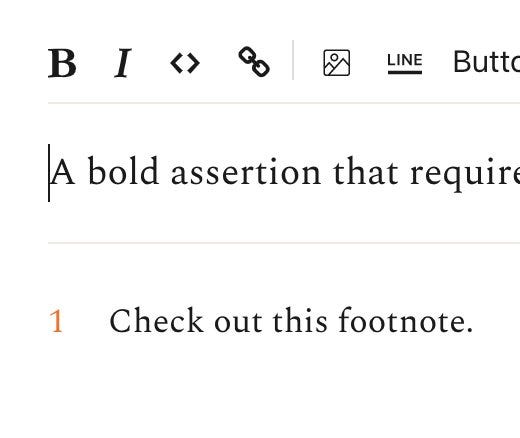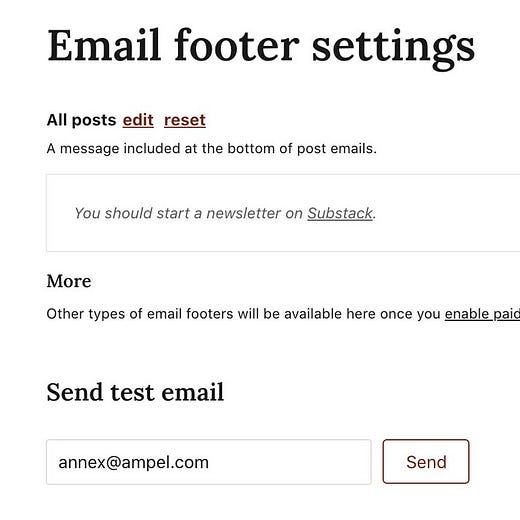This Week in Substack (2/5/21)
New Substack newsletters; new competition for Substack; new features
Welcome to new subscribers! And to previous subscribers too. And also to everyone reading this. :)
“This Week in Substack” will eventually be a perk of paid subscription. But for now, it’s for all readers of this newsletter.
If you have suggestions for future editions of “This Week in Substack,” please let me know in the comments or by email.
New Newsletters
At least 23 newsletters published their first content (beyond an “About” post) during the past two weeks.
Substack does not have a list of new newsletters. Perhaps it should — a list could give these newsletters a welcome boost. However, I doubt Substack would want spam newsletters to appear automatically on Substack’s main website. Substack could engage in some light content moderation, in order to weed out spam and allow newsletters with content onto the list.
Currently, one must browse all newsletters in each Discover category to find the ones that launched recently. (Note: Some newsletters may have published their first content recently even though they launched months or years ago. And some newsletters might not be listed on Substack. I’m not aware of an easy way to identify such newsletters.)
Here are the new newsletters I’ve found:
August's Newsletter: "Art, words, etc."
Bring the Donuts: "An occasional digest of product management advice and useful links from Ken Norton"
BuyUcoin Newsletter: "Premier Indian Cryptocurrency Exchange since 2016 having 45+ Pairs like BTC, DOT, Link, ETH, and More."
Chris Cantino's Newsletter: "Consumer, commerce, media & marketplaces."
The Cycle: "Your companion to Major League Baseball’s seasons"
diabolical: "Entertainment, gaming, culture, and commentary by Erik Kain. Mostly evil."
Edible Homefront: "Edible Santa Barbara's newsletter bringing you delectable bits and bites from Santa Barbara and beyond."
FRTN Newsletter: "Rejoignez plus de 6 000 abonnés et recevez des ressources intéressantes pour vous aider à monter votre Startup à partir de zéro 🚀 (Écrite avec passion et ❤️) "
The Healthiest Goldfish: "Health is not healthcare. I write about the foundational forces that shape health."
History, etc: "Notes on what I'm reading, writing, filming and thinking"
Hot Stocks: "Discover emerging stocks before they take off."
How Jessica Reads: "Book, Memes, and Delightful Things"
It Bears Mentioning: "Sometimes race, sometimes language, sometimes something else. Every week."
Look What You Made Me Do: "From the frontlines to the backline: All Eugene S. Robinson, All the time"
Over Here: "Free monthly essayettes from over here, plus feminism, the creative life, and community conversations. "
Reddit Investor Newsletter: "The hottest meme stocks that are being pumped to on Reddit"
Sharing Orca Eats: "Food, eating, environment and food, sharing, community."
Silicon Valley Dojo: "Una community per mettere in contatto startup, università, investitori, acceleratori e aziende italiane con Silicon Valley, la sua cultura e i suoi founder."
Spice Weekly: "Weekly Cooking Newsletter from one of India's best chef."
Tiny Vineyards: "My journey becoming a boutique winemaker"
Trent's Newsletter: "Tech. Politics. Crypto. Health."
Weekly Briefing: "We dig deep to find the latest and greatest ideas on leadership, and deliver them straight to your email inbox every Sunday."
Zoot's Brain Dump: "Navigating this world in an aging body with a non-stop brain."
New Competition
Substack co-founder Hamish McKenzie gave his thoughts on the news that Twitter and Facebook were getting into the newsletter business. Essentially McKenzie indicated that Twitter and Facebook were welcome to try newsletters, but that Substack would have an advantage because of its business model — unless maybe if Twitter and Facebook adopt the same business model.
Some writers will surely at least try Twitter and Facebook’s newsletters. Twitter and Facebook have many users and thus potential readers and subscribers.
But, as McKenzie indicates, newsletters are not Twitter and Facebook’s core business. Twitter and Facebook specialize in short posts and links. People are not accustomed to paying for content on those services. (People are used to something akin to subscribing to content. But I doubt that free subscriptions by themselves would sustain a newsletter business within Twitter or Facebook, unless the newsletters were monetized by advertising.) Can Twitter and Facebook convince writers and readers that their platforms are an appropriate location for paid long-form subscription content?
To me, the most intriguing part of McKenzie’s post is at the end:
[Facebook and Twitter] have announced very plainly that they intend to take our business.
All very well. They’re in our sights too.
What does that mean exactly? I don’t think it means that McKenzie believes that Facebook and Twitter will eventually disappear and that everyone will have a Substack social media account instead. Rather, I infer that McKenzie is saying that Substack’s content and atmosphere will be increasingly appealing to people who are dissatisfied with Facebook and Twitter’s demands on their attention.
Perhaps McKenzie is also thinking about potential enhancements of Substack’s social network aspects. Personally, I like comments and threads on Substack, but can envision improvements, such as the same kinds of editing and embedding features as on the main posts. Also I feel there’s an opportunity to increase the utility of user profiles (for users who don’t prefer to remain anonymous or low-profile) and to allow interaction among users beyond comments and replies.
New Features
Substack announced two new features (on Twitter, perhaps ironically):
I’ll end this post by trying one of these features.1
Hey, it works! :)



